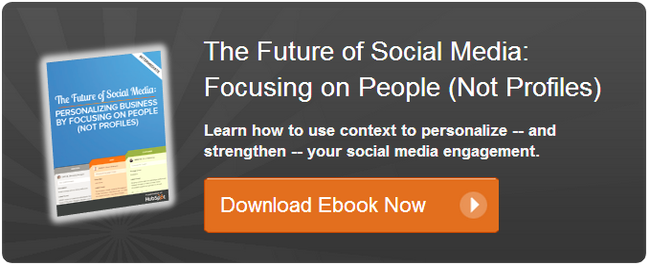
在yesterday’sSocial Media Measurement webinar, we addressed the numbers as well as a range of questions submitted by our audience. In this blog post we highlighted the top six questions for those of you who won’t have time to watch the entireon-demand webinar:
1.你应该测量社交媒体?
“No,” said Jay Baer, “because it is not about how many things you are measuring. It is about measuring the right things: the things that make you money, save you money, or both.” Our panelists pointed out that businesses shouldn’t overembrace social media measurement because that might present more conflicting points and stir further questions in an nonconstructive way. Sopick the right metric—which could be traffic, leads, engagement—and design your strategy based on that.
2. What success metrics should you be worried about?
“The goal is not to be good at social media,” Jay said. “The goal is to be good at business because of social media.” While the size of your reach on Facebook, Twitter and LinkedIn is definitely important, it is more critical to see if the people on these channels are behaving in a way that brings you business.
A singular data point, such as number of Facebook likes, is not contextual or demonstrative of success. You should knowwhythese people matter and what they are doing for your company. So stop obsessing over your number of fans and followers; start measuring behavior through referrals and conversions.
3. How do you evaluatebehavior?
One way you can start evaluating the behavior of your prospects is by looking into all the touch points along the sales funnel. In most cases, people are in a research and information-gathering mode, which means they are willing to download reports, view videos and sign up for webinars; they are not going to make a purchase.
As a marketer, you want to identify the value of each conversion event—for instance, someone who came from Twitter, downloaded your ebook and ultimately became a customer. This type ofclosed-loop marketingis invaluable and is something you can do with HubSpot.
4. Should I be present on all platforms?
仅仅因为一个社会媒体频道工作meone doesn’t mean it is the right platform for you. If your customers are not really on Twitter, maybe you should focus your efforts elsewhere. As Amber said, you need a strategy that is “tool-agnostic.” Make sure your mechanisms are flexible enough to let you adapt to new tools.Besocial, don’t justdosocial.
5. What about the value of a Facebook like or a Twitter follower?
How do you determine the value of your connections on Twitter/Facebook/LinkedIn? This is a question many marketers are now posing. When you start experimenting with it, make sure your data is not just anecdotal and is based on long-term measurement. You will need to use a statistical significant data size to determine that number. “You have got to marinate these numbers for a little while,” said Amber. From a business decision perspective, you need to look at things deeper and measure overtime.
One way to go about calculating this is to start backwards: instead of thinking how much a Twitter follower is worth, think about how much a lead is worth and take into account your average visitor-to-lead conversion rate.
6. What are some of your favorite social media monitoring tools?
Some of the social media monitoring tools we mentioned during the webinar includeSocial Mention,Radian6,PostRank,Authority Labs,HubSpot,Twitter GraderandArgyle.
Did you have any other social media measurement questions we should discuss? Post them in the comments section below!

Originally published Apr 20, 2011 9:00:00 AM, updated July 03 2013
Topics:
Social MediaDon't forget to share this post!
Related Articles

Expand Offer
Social Media Content Calendar Template
Get it now